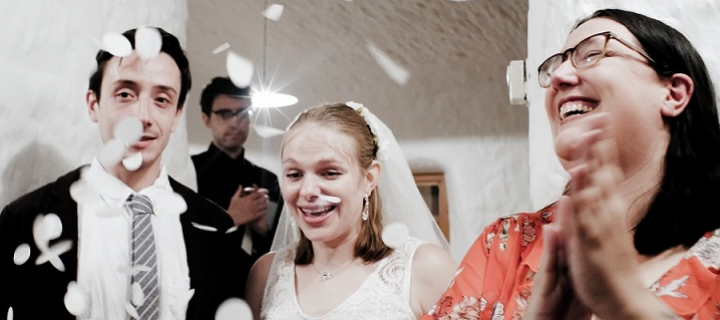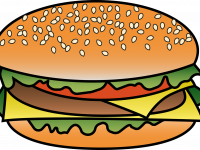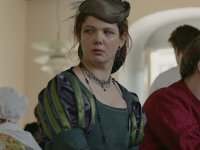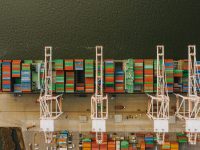[This article is also available in Spanish, at: http://vivologia.es/a-traves-de-los-ojos-de-otra-persona-una-confesion/
Thank you to Vivologia for translating it!]
Magician took me near the water, where the others were, put his hands on my shoulders while facing me and said: “you made me look at things in a different way before, and I’m thankful for that. So here’s my gift to you.” His voice and posture started to change, shifting effortlessly from a casual, conversational tone to a solemn, ritualistic one. “I will give you my own eyes”, he chanted as he put a blindfold on his face, “so you can look at the world from a different view, so you can see and take pictures that you would not see and take. I will be blind so you can see.” For about an hour, I went around and took pictures trying hard to imagine what Magician would see and react to.

Photo by Stefano Kewan Lee as the character Gaze in the larp La Sirena Varada (2017).
Of course, I failed. This was only my second time taking pictures at a larp, and my very first time trying to do so in character. The larp was the third and final run of Somnia’s La Sirena Varada (2017), and I had the opportunity to play it as a photographer character who could take all his pictures in-game. Coming into the larp I was eager to try that experience and curious to see how it would work out. I usually play for immersion and, like many others, had quite a few deep and transformative experiences while inhabiting the mind and physical space of a fictional character. Getting to do that while also indulging in my newfound photography hobby seemed like too good an opportunity to pass up.
During the larp itself though it became clear to me that things were not working out at all. I was constantly switching back and forth from “character mode”, where I would be actually immersed in Gaze (my photographer character), and “photographer mode”, where I would feel instantly pulled back to my usual self and took pictures in the best way I knew how, but without any thought of how would Gaze take them. As the larp progressed I felt increasingly frustrated by the fact that I was indeed failing to take full advantage of the opportunity that I was given. No wonder I couldn’t honour Magician’s gift. How could I see the world through his eyes when I couldn’t even see it through Gaze’s eyes?
When I got back and developed the film, I had a very clear confirmation of what I experienced at the larp: as much as I loved taking them and printing them, those pictures were mine and reflected the way I as a player saw the larp while it had nothing to do with Gaze’s outlook and personality.
Moreover, what I experienced was so clear and definitive that it felt inevitable to me: you can either immerse yourself in a character, or you can focus on the exacting job of taking pictures the best way you can. There can be no middle ground, and at the point a perfect synergy between the two mindsets, where you end up fully experiencing a character and at the same time producing pictures that fully reflected that character’s personality, that was borderline unthinkable for me.
All the experiences I had in the following larps only strengthened my conclusion. I would usually just take pictures out of character, but was occasionally offered a NPC or a full fledged character to play with as I took pictures. And every time I would experience the very same back-and-forth between the two states of mind. After a while it was clear to me that this was how things worked (or rather, failed to work) for me. Others might be able to pull it off, but I was not among them, and I made my peace with it.
Then SALT happened.
The larp SALT (2018) focuses on a small group of civilians, normal people trying to find shelter and survive during a civil war that has ripped their country apart. In order to keep things as 360 as possible it’s not unusual for larp designers and organisers who want a photographic documentation of their larp to include, when the setting allows for it, one or more characters that will take pictures while not jeopardising immersion for everyone else. SALT had similar goals so I got offered a character that knew his way around a camera and was willing to use it.
Experience told me that I should expect some variation of the journalist/reporter type that I usually get, but I was wrong. What a character Vincenzo was! A weirdo who would obsessively collect useless trinkets and give them human names, a loner who would rather write in his own diary rather than talk to the people around him. He was indeed a photographer by trade, but his job was to take pictures of dead people at the morgue. He took me by surprise, and forced me to really think about how I could approach not just the usual elements of character interpretation and immersion (posture, voice, language, etc.) but also his photography. At that time I was still convinced that it was impossible for me to produce work while in character though, so the only thing I could do was to pack a longer lens than usual. I usually favour moderate wide to normal lenses; this time I chose a moderate telephoto lens, hoping it would at least change things up a little on a purely visual level.

Photo by Stefano Kewan Lee as the character Vincenzo in the larp SALT (2018).
The larp itself was for me an excruciating exercise in isolation and incommunicability as it was almost too easy to slip into Vincenzo’s shoes. And when it came to taking pictures, the only deliberate thing I did was to avoid some of the most obvious shots I would normally take while looking for action, character and narrative. Instead I tried to let Vincenzo take the lead and guide my hand and eye. So I took pictures of objects, of empty rooms, and when I did include people, it was always from a place of distance, both physical and emotional. Because I almost never take still life pictures, and when I do they are always very bad, when the larp was over and I packed things up, I was not at all sure of what I actually got.
It turns out I didn’t have much, as one of the rolls of film got jammed in the camera and was completely ruined. What I did manage to salvage was very surprising to me. Sure, I did remember taking those pictures of scattered playing cards, empty tin cans and empty rooms. But they were very different from my previous attempts at still life. They had a quality to it that really reflected Vincenzo’s personality and attitude, and that I wouldn’t know how to replicate by myself. It appeared that for once I did manage to be immersed in a character and at the same time produce work that actually reflected that character’s gaze, and not my own. I was not expecting that at all, and wondered if I had to revise my ideas on the matter. It didn’t take long for me to realize that SALT as a larp had a profound effect on me, and more importantly that Vincenzo was far removed from a simple documentarian character. He was so specific, and so far removed from my usual methods, that no wonder I was able to make something very different. “This is the exception that proves the rule,” I said to myself. “You’ll go back to the usual mindset switching with the next reporter character that you get.” There was no doubt about it in my mind.

Photo by Stefano Kewan Lee as the character Vincenzo in the larp SALT (2018).
A few months later I took pictures at the international run of Desaparecidos (2019). The larp is set at a center of detention for political dissidents during Pinochet’s regime in Chile, and tells the dramatic stories of the people detained there. At first the organisers just wanted an out of game photographer, but a few days before the larp I was also asked to be an in-game reporter non-player-character (NPC) for a few hours. This was strictly for plot reasons and I did not have a full fledged character. My task as an NPC was to kiss the authorities’ asses while secretly trying to help the dissidents to get some messages out of there. Having done that, I would once again go out of character and be my usual “invisible” presence at the larp. Almost on a whim, I decided to bring my period appropriate film camera in addition to my digital one so I could look the part while taking pictures as an NPC. My expectation was to end up with essentially one big set of pictures, where some happened to be in colour, and some in black and white.
What I was not expecting at all is that when I acted as a reporter and the players reacted to my presence, this NPC character who barely had a name started to take hold on me, and I felt genuinely concerned about the prisoners, and I was genuinely faking smiles while pretending to interview the colonels and dignitaries, and was genuinely worried that they might find out I was not just taking pictures of their boardrooms and dinner parties, but also of things I was not supposed to see, like the way the prisoners were treated, much less to document them. All of that disappeared when I went out of character and the players stopped reacting to my presence, so while I was there it mostly felt like business as usual: switching back and forth between taking pictures and playing a character, keeping the two separate.

Photo by Stefano Kewan Lee as a NPC photographer in the larp Desaparecidos (2019).
When I went home and started working on the pictures it became clear that I had two different sets in my hands. The colour set reflected my usual way of taking pictures at a larp, trying to communicate the mood and the narrative of the event while focusing on scenes as a whole, more than single character portraits. The black and white set that I mostly took in-character was… puzzling. It felt like I was looking at the work of someone who had been there with those people and was actually trying to document what he could so the world could know about them. Yes, the two sets clearly shared their style rooted in the documentary genre, but their visual language was also somewhat different. And it was not just the difference between colour and black and white. The set I took while in character had less action, but the action was more stark and direct, while the colour set was more dramatic and almost theatrical. The black and white set had way more portraits, and the people were looking directly in camera, while the colour set hardly had portraits and no one was ever looking in camera. More importantly, the in-character black and white set had a sense of empathy and urgency that the colour, out of character set simply lacked. It was clear that the NPC reporter somehow took hold of me, forced me to immerse in his experience, and that I took pictures as someone other than myself without even realising it.
I was supposed to take pictures in game as an NPC only on part the first day, while being out of game both at the beginning of the larp and for the whole second (and last) day. And of course this is what I did, but because I still had a few rolls of film to use, I decided to keep using both cameras while I was taking pictures. Imagine my surprise when I could still see that all the black and white photos belonged to the reporter, even those I thought I was taking while out of character! For some reason the simple act of raising to my eye the same camera that I used as a character was enough for me to unknowingly slip back in the mind of that reporter. What was going on? How was it possible that something that had mostly eluded me so far (with the exception of SALT, sure, but that didn’t count, right?) could suddenly sneak up on me like that, with a NPC reporter of all characters? I had to revise my ideas on taking pictures while larping! It was time to dig deeper, but I needed the right larp for that.

Photo by Stefano Kewan Lee as a NPC photographer in the larp Desaparecidos (2019).
Walpurgis is heavily inspired by old witchcraft movies and the psychedelic ‘60s and ‘70s. It plays like a bad dream, where members of a coven create from themselves a surreal and nightmarish where being inconsistent and wrong is not just tolerated: it’s the name of the game. My character, named Marcello, was a controversial filmmaker known for his provocative yet striking visual style. Even more importantly, a key game technique was the Second Sight, where every character could see anything that was happening in front of them in a different way, one that suited their vision, worldview or intuition, and use that to create content and enrich interactions while playing. This combination of emphasis on the surreal aspects of vision and explicit permission to mess things up provided the perfect opportunity to explore this idea of producing work while being someone else in a more explicit, deliberate way without worrying too much about having to come up with something conventionally usable as a larp photography product. Of course, as I do for every larp that I take pictures at, I did my homework and studied the iconography and visual style and language of the sources of inspirations for the larp itself. During that process I came across the idea of using crystals and prisms in front of the lens in order to create kaleidoscopic, fragmented images. So I bought some of those and made a couple of tests at home, with lackluster results. As I left for the larp, with a bag full of stuff that I didn’t really know how to use and a head full of confused ideas on what I wanted to achieve, I felt as clueless and in over my head as I could possibly be. Given the nature of the larp, that was probably a good thing.

Photo by Stefano Kewan Lee as the character Marcello in the larp Walpurgis (2019).
As I let Marcello take over and immersed myself in the world of Walpurgis, I would occasionally catch myself drifting out of the game and making decisions that made sense photographically but not necessarily for my character. “Hey, those witches look like they’re up to something interesting. Join them and take pics, even though you have no in game reason to,” and so Marcello did. “Hey, I know you really want to keep interacting directly with this scene, but you should really document it.” And so on, you get the picture.
The final result reads to me like a collaboration between Marcello and myself. The most striking aspect of this collaboration is how the images where I used the crystals turned out just fine. I as a photographer never used them before, and certainly never touched them since. But I had decided that a fragmented, kaleidoscopic imagery was part of Marcello visual’s style, and it seems like he knew very well how to use them to full effect, in ways that I could not anticipate. With the flick of a wrist he could evoke a hallucinatory feeling, or ghostly presences, or even demonic, infernal flames. I promise I could not replicate those results if my life depended on it. Mission accomplished then? Not quite yet. As I hinted above, there was still the occasional drift out of character, and as much as many of the images are unquestionably Marcello’s, overall the choice of subject was still mine, so it felt like I failed to take the experience one step further. On the other hand, what I got was enough to make me further question my belief that being a character and taking pictures don’t mix, and I was looking forward to the next opportunity to go even deeper.

Photo by Stefano Kewan Lee as the character Marcello in the larp Walpurgis (2019).
Our Last Year is a larp loosely inspired by Lars Von Trier’s Melancholia, and follows a year in the life of a group of survivalists as they prepare for an asteroid that may hit planet Earth and make its surface inhabitable for a generation. Laurie, my character, had a terminal illness that made him think and act a little weird. He also had a strong drive to live life at its fullest, and to make meaningful, enriching connections with the people around him. Oh and of course, he was a hobbyist photographer. While the character in general was very clear to me, I was not sure how to approach my photography to the larp. The visual references for the larp didn’t really align with the character concept, so I have to admit that this time I did the least amount of research and preparation before packing for the event. I had this vague idea of trying to focus on the characters more this time, but that was it.
It was only towards the end of the larp that I realised that… I never drifted out of character! I had allowed Laurie to take pictures in a way that made sense to him without me trying to go art director on him. And for better or worse, this was very much reflected in the resulting pictures.

Photo by Stefano Kewan Lee as the character Laurie in the larp Our Last Year (2019).
On one hand, I was disappointed. This was definitely not a very strong set of images. They mostly looked like snapshots from someone’s holiday, and I was hoping for a little more than that. On the other hand, these looked like snapshots from someone’s holidays! And that’s not my way of taking pictures ever, not even during my own holidays! The focus on the characters was even stronger than in Desaparecidos, and there was a feeling of simple, spontaneous intimacy that I never managed to evoke before. Even more surprisingly, when I showed the pictures some of the players commented that while they could see their faces in the photos, they didn’t see themselves at all, but only (and fully) their characters. This is one of the best compliments that I as a larp photographer could ever hope for, and I finally got it after allowing myself to take slightly crappy photos through someone else’s eyes.
Was I done then? Had I cracked the code? Not by a long shot. Both before and after Our Last Year I took pictures at larps where I could not achieve that level of immersion, so I had to decide between playing a character and being a photographer, as usual. But the experience did finally show me that I had been wrong in my conclusions before, and that it is indeed possible and maybe sometimes even desirable to let your character take over and do the work in ways that you could not do by yourself. How to attain that state reliably? I still don’t know. But maybe being clueless about it is exactly what it takes. It’s not just a matter of focus and concentration. I need to let myself be open and to give up control in order for this kind of magic to happen.
I can’t wait to hand over the camera to the next character, and see what happens.
Photo credit: Stefano Kewan Lee as the character Laurie in the larp Our Last Year (2019).
This article will be published in the upcoming companion book Book of Magic and is published here with permission. Please cite this text as:
Lee, Stefano Kewan. “Through Someone Else’s Eyes: A Confession.” In Book of Magic, edited by Kari Kvittingen Djukastein, Marcus Irgens, Nadja Lipsyc, and Lars Kristian Løveng Sunde. Oslo, Norway: Knutepunkt, 2021. (In press).






